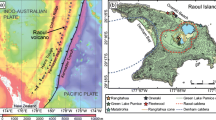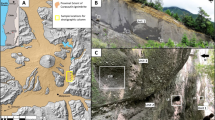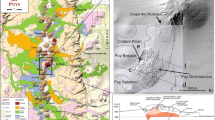Abstract
Bubble and crystal textures provide information with regard to the kinetics of the vesiculation and crystallization processes. They also provide insights into the fluid mechanical behavior of magma in a conduit. We performed textural (bubble and crystal) and compositional analyses of pyroclasts that were obtained from the Tenjo pyroclastic flow, which resulted on account of the eruption in 838 A.D. on Kozu Island, about 200 km south of Tokyo, Japan. Pyroclasts in one flow unit (300∼2,060 kg/m3; average density 1330 kg/m3) can be classified into three types on the basis of vesicle textures. Type I pyroclasts have small isolated spherical bubbles with higher vesicularities (67–77 vol.%) and number density (10.8–11.7 log m−3). Type II pyroclasts have vesicularities similar to type I (61–69 vol.%), but most bubbles exhibit evidences of bubble coalescence, and lower number densities than type I (8.9–9.5 log m−3). Type III pyroclasts contain highly deformed bubbles with lower vesicularities (16–34 vol.%) and number densities (8.2–9.0 log m−3). The microlite volume fraction (DRE converted) also changes consistently across type I, type II, and type III as 0.06, 0.08, and 0.10–0.15, respectively. However, the number density of the microlites remains nearly invariant in all the pyroclast types. These facts indicate that the variation in the microlite volume fraction is controlled not by the number density (i.e., nucleation process), but by the size (i.e., growth process); the growth history of each type of microlite was different. Water content determinations show that the three types of pumices have similar H2O contents (2.6±0.2 wt%). This fact implies that all three types were quenched at nearly the same depth (35±5 MPa, assuming that the magma was water-saturated) in the conduit. If the crystal sizes are limited only by growth time, a variation in this parameter can be related to the residence time, which is attributed to the flow heterogeneity in the conduit. By assuming a laminar Poiseuille-type flow, these textural observations can be explained by the difference in ascent velocity and shearing motion across the conduit, which in turn results in the differences in growth times of crystals, degrees of deformation, and bubble coalescence. Consequently, for crystals in the inner part of the conduit, the crystal growth time from nucleation to quenching is shorter than that near the conduit wall. The vesicle texture variation of bubbles in types I, II, and III results from the difference in the deformation history, implying that the effect of degassing occurred primarily towards the conduit wall.












Similar content being viewed by others
References
Alidibirov MA (1994) A model for viscous magma fragmentation during volcanic blasts. Bull Volcanol 56:459–465
Alidibirov M, Dingwell DB (1996) Magma fragmentation by rapid decompression. Nature 380:126–148
Alidibirov M, Dingwell DB (2000) Three fragmentation mechanisms for highly viscous magma under rapid decompression. J Volcanol Geotherm Res 100:413–421
Blower JD, Keating JP, Mader HM, Phillips JC (2002) The evolution of bubble size distributions in volcanic eruptions. J Volcanol Geotherm Res 120:1–23
Blundy J, Cashman KV (2001) Ascent-driven crystallization of dacite magmas at Mount St. Helens, 1980–1986. Contrib Mineral Petrol 140:631–650
Burnham CW (1975) Water and magmas: a mixing model. Geochim Cosmochim Acta 39:1077–1084
Büttner R, Dellino P, Zimanowski B (1999) Identifying magma-water interaction from the surface features of ash particles. Nature 401:688–690
Büttner R, Dellino P, Volpe LL, Lorenz V, Zimanowski B (2002) Thermohydraulic explosions in phreatomagmatic eruptions as evidenced by the comparison between pyroclasts and products from Molten Fuel Coolant Interaction experiments. J Geophys Res 107: doi:10.1029/2001JB000511
Carslaw and Jaeger (1959) Conduction of heat in solids. Oxford University Press, Oxford, pp 1–510
Cashman KV, Ferry JM (1988) Crystal size distribution (CSD) in rocks and the kinetics and dynamics of crystallization, III, Metamorphic crystallization. Contrib Mineral Petrol 99:401–415
Cashman KV, Marsh BD (1988) Crystal size distribution (CSD) in rocks and the kinetics and dynamics of crystallization, II, Makaopuhi lava lake. Contrib Mineral Petrol 99:292–305
Castro JM, Mercer C (2004) Microlite textures and volatile contents of obsidian from Inyo volcanic chain, California. Geophys Res Lett 31: doi:10.1029/2004GL020489
Couch S, Harford CL, Sparks RSJ, Carroll MR (2003a) Experimental constraints on the conditions of formation of highly calcic plagioclase microlites at the Soufriere Hills volcano, Montserrat. J Petrol 44: 1455–1475
Couch S, Sparks RSJ, Carroll MR (2003b) The kinetics of degassing-induced crystallization at Soufriere Hills volcano, Montserrat. J Petrol 44:1477–1502
Devine JD, Gardner JE, Brack HP, Layne GD, Rutherford MJ (1995) Comparison of microanalytical methods for estimating H2O contents of silicic volcanic glasses. Am Mineral 80:319–328
Friedman II, Smith RL, Long WD (1966) Hydration of natural glass and formation of perlite. Geol Soc Am Bull 77:323–327
Gaonac'h H, Stix J, Lovejoy S (1996) Scaling effects on vesicle shape, size and heterogeneity of lavas from Mount Etna. J Volcanol Geotherm Res 74:131–153
Geschwind CH, Rutherford MJ (1995) Crystallization of microlites during magma ascent: the fluid mechanics of 1980–1986 eruptions at Mount St. Helens. Bull Volcanol 57:356–370
Gonnermann HM, Manga M (2003) Explosive volcanism may not be an inevitable consequence of magma fragmentation. Nature 426:432–435
Gray NH (1970) Crystal growth and nucleation in two large diabase dikes. Can J Earth Sci 7:366–375
Hammer JE, Cashman KV, Hoblitt RP (1999) Degassing and microlite crystallization during pre-climactic events of the 1991 eruption of Mt. Pinatubo, Philippines. Bull Volcanol 60:355–380
Hammer JE, Cashman KV, Voight B (2000) Magmatic processes revealed by textural and compositional trends in Merapi dome lavas. J Volcanol Geotherm Res 100:165–192
Hammer JE, Rutherford MJ (2002) An experimental study of the kinetics of decompression-induced crystallization in silicic melt. J Geophys Res 107: doi:10.1029/2001JB000281.
Heiken G, Wohletz K (1985) Volcanic ash. University of California Press, pp 1–246
Higgins MD (1998) Origin of anorthosite by textural coarsening: quantitative measurements of a natural sequence of textural development. J Petrol 39:1307–1325
Higgins MD (2000) Measurement of crystal size distributions. Am Mineral 85:1105–1116
Higgins MD (2002) Closure in crystal size distributions (CSD), verification of CSD calculations, and the significance of CSD fans. Am Mineral 87:171–175
Higgins MD and Roberge J (2003) Crystal size distribution (CSD) of plagioclase and amphibole from Soufriere Hills volcano, Montserrat: evidence for dynamic crystallization/ textural coarsening cycles. J Petrol 44:1401–1411
Houghton BF, Wilson CJN (1989) A vesicularity index for pyroclastic deposits. Bull Volcanol 51:451–462
Isshiki N (1982) Geology of the Kozushima district (1:50000 map). Geol Surv Jpn, pp. 75
Ito J (1990) Factor analysis of disaster at Niijima and Kozu-shima, Izu (in Japanese). Chikyu Monthly 21:417–423.
Klug C, Cashman KV (1994) Vesiculation of May 18, 1980, Mount St. Helens magma. Geology 22:468–472
Klug C, Cashman KV, Bacon CR (2002) Structure and physical characteristics of pumice from the climactic eruption of Mount Mazama (Crater Lake), Oregon. Bull Volcanol 64:486–501
Larsen JF, Denis MH, Gardner JE (2004) Experimental study of bubble coalescence in rhyolitic and phonolitic melts. Geochim Cosmochim Acta 68:333–344
Marsh BD (1988) Crystal size distribution (CSD) in rocks and the kinetics and dynamics of crystallization 1. Theory. Contrib Mineral Petrol 99:277–291
Mcbirney AR, Murase T (1970) Factors governing the formation of pyroclastic rocks. Bull Volcanol 64:486–501
Melnik O, Sparks RSJ (1999) Nonlinear dynamics of lava dome extrusion. Nature 402:37–41
Morgan GB, London D (1996) Optimizing the electron microprobe analysis of hydrous alkali aluminosilicate glasses. Am Mineral 81:1176–1185
Murase T, Mcbirney AR (1973) Properties of some common igneous rocks and their melts at high temperatures. Geol Soc Am Bull 84:3563–3592
Nakada S, Motomura Y (1999) Petrology of the 1991–1995 eruption at Unzen: effusion pulsation and groundmass crystallization. J Volcanol Geotherm Res 89:173–196
Namiki A, Hatakeyama, Toramaru, Kurita KA, Sumita I (2003) Bubble size distributions in a convecting layer. Geophys Res Lett 30: doi:10.1029/2003GL017156
Nekvasil H (1990) Reaction relations in the granite system: implications for trachytic and syenitic magmas. Am Mineral 75:560–571
Nekvasil H, Lindsley DH (1990) Termination of the 2 feldspar + liquid curve in the system Ab-Or-An-H2O at low H2O contents. Am Mineral 75:1071–1079
Nekvasil H (1992) Ternary feldspar crystallization in high-temperature felsic magmas. Am Mineral 77:592–604
Nielsen CH, Sigurdsson H (1981) Quantitative methods of electron microprobe analysis of sodium in natural and synthetic glasses. Am Mineral 66:547–552
Noguchi S, Morishita T, Toramaru A (2004) Corrections for Na-loss on micro-analysis of glasses by electron probe X-ray micro analyzer (in Japanese with English abstract). J Mineral Petrol Econ Geol 33:85–95
Polacci M, Papale P, Rosi M (2001) Textural heterogeneities in pumices from the climactic eruption of Mount Pinatubo, 15 June 1991, and implications for magma ascent dynamics. Bull Volcanol 63:83–97
Proussevitch AA, Sahagian DL, Kutolin VA (1993) Stability of forms in silicate melts. J Volcanol Geotherm Res 59:161–178
Richet P, Bottinga Y (1986) Thermochemical properties of silicate glasses and liquids; a review. Rev Geophys 24:1–25
Rutherford MJ, Hill PM (1993) Magma ascent rates from amphibole breakdown: an experimental study applied to the 1980–1986 Mount St. Helens eruptions. J Geophys Res 98:19667–19685
Sahagian DL, Proussevitch AA (1998) 3D particle size distribution from 2D observations: Stereology for natural applications. J Volcanol Geotherm Res 84:173–196
Saltikov SA (1958) Stereometric metallography, 2nd edn. Metallurgizdat, Moscow, pp 1–446
Self S, Sparks RSJ (1978) Characteristics of widespread pyroclastic deposits formed by the interaction of silicic magma and water. Bull Volcanol 41:196–212
Shimano T, Koyaguchi T (2001) Eruption styles and degassing process of ascending magma of the 1813 eruption of Suwanose-jima volcano, southwest Japan (in Japanese with English abstract). Bull Volcanol Soc Japan 46:53–70
Sparks RJS (1978) The dynamics of bubble formation and growth in magmas, a review and analysis. J Volcanol Geotherm Res 3:1–37
Spieler O, Dingwell DB, Alidibirov M (2004) Magma fragmentation speed: an experimental determination. J Volcanol Geotherm Res 129:109–123
Stasiuk MV, Barclay J, Carroll MR, Jaupart C, Ratté, Sparks RSJ, Tait SR (1996) Degassing during magma ascent in the Mule Creek vent (USA). Bull Volcanol 58:117–130
Suga K, Kobayashi K, Kanemaki M, Miyahara T, Endo K (1992) Pyroclastic deposits in southern part of Kozushima (in Japanese with English abstract). Bull Volcanol Soc Jpn 37:71–83
Taniguchi H (1977) Volcanic geology of Kozu-shima, Japan (in Japanese with English abstract). Bull Volcanol Soc Jpn 22:133–147.
Taniguchi H (1980) Some volcano-geological significances of the hydration layer observed in the glassy groundmass of Kozu-shima rhyolite (in Japanese with English abstract). Bull Volcanol Soc Jpn 25:217–229
Togashi S (1984) 14C ages pf charcoal from pyroclastics of Tenjosan volcano, Kozushima, the Izu Islands, Japan (in Japanese with English abstract). Bull Volcanol Soc Jpn 29:277–283
Toramaru A (1990) Measurement of bubble size distributions in vesiculated rocks with implications for quantitative estimation of eruption parameters. J Volcanol Geotherm Res 43:71–90
Toramaru A (1991) Model of nucleation and growth of crystals in cooling magmas. Contrib Mineral Petrol 108:106–117.
Toramaru A (2001) A numerical experiment of crystallization for a binary eutectic system with application to igneous textures. J Geophys Res 106:4037–4060
Tsuya H (1929) Volcanoes of Kozu-shima. Bull Earthquake Res Inst 7:269–334
Voorhees PW (1985) The theory of Ostwald ripening. J Stat Phys 38:231–252
Westrich HR (1987) Determination of water in volcanic glasses by Karl Fischer titration. Chem Geol 63:335–340
Wylie JJ, Voight B, Whitehead JA (1999) Instability of magma flow form volatile-dependent viscosity. Science 285:1883–1885
Zimanowski B, Büttner R, Lorenz V (1997) Premixing of magma and water in MFCI experiments. Bull Volcanol 58:491–495
Acknowledgement
We would like to thank K. Endo and M. Ohno for helpful discussions and their encouragement during this study. The critical comments of S. Arai, A. Ishiwatari, T. Morishita, and A. Namiki served to considerably clarify this work. The analysis of the Karl Fischer titration was performed under the guidance of S. Nakada. We also thank O. Spieler, M. Higgins, and J. Stix for their critical reviews and comments that significantly improved the paper. This paper was greatly modified based on the detailed comments and corrections of I. Sumita. This work was partly supported by a Grant-in-Aid for Scientific Research from MEXT (No. 14080202 and No. 17340131).
Author information
Authors and Affiliations
Corresponding author
Additional information
Editorial responsibility J. Stix
Appendix A
Appendix A
Crystal growth induced by cooling at the conduit wall
The crystal growth induced by cooling at the conduit wall may produce varying degrees of crystallization processes. The cooling rate of magma is a function of the distance from the conduit wall, assuming a simple one-dimensional conductive cooling without vertical flow. In such a simple case, the solution for the thermal conduction equation is controlled by a dimensionless quantity κ∼tx 2, where κ is the thermal diffusivity, t is time, and x is the distance from the conduit wall (e.g., Carslaw and Jaeger 1959). Here, we consider the relationship between the ascent timescale of magma and the thermal diffusion time scale (Fig. A1); the characteristic time for the ascending magma along the conduit (t flow) is represented as a function of the vertical distance H and the ascent velocity v:
In general, the ascent velocity during typical explosive eruptions is expected to be high, at least 1 m/s. When we assume that the ascent velocity v is 1 m/s and the vertical distance H is 1 km along the conduit, the calculated ascent time t flow is 1.0×103 s. On the other hand, during this ascent of magma, the propagation distance of conductive cooling l from the conduit wall can be represented as a function of magma ascent time and thermal diffusivity:
After obtaining the heat capacity, melt density, and specific heat proposed by Murase and Mcbirney (1973) and Richet and Bottinga (1986), the thermal diffusivity κ is calculated as 5.5×10−7 m2/s. Thus, the distance of the conductive cooling l is approximately 0.02 m while the magma traverses a vertical distance of 1 km. This implies that the conductive cooling may influence a negligible spatial scale from the conduit wall. Therefore, we believe that crystal growth induced by the cooling at the conduit wall does not play a significant role in the microlite growth process that results in different microlite sizes in various vesicular types.
Rights and permissions
About this article
Cite this article
Noguchi, S., Toramaru, A. & Shimano, T. Crystallization of microlites and degassing during magma ascent: Constraints on the fluid mechanical behavior of magma during the Tenjo Eruption on Kozu Island, Japan. Bull Volcanol 68, 432–449 (2006). https://doi.org/10.1007/s00445-005-0019-4
Received:
Accepted:
Published:
Issue Date:
DOI: https://doi.org/10.1007/s00445-005-0019-4





